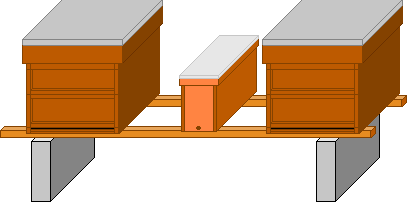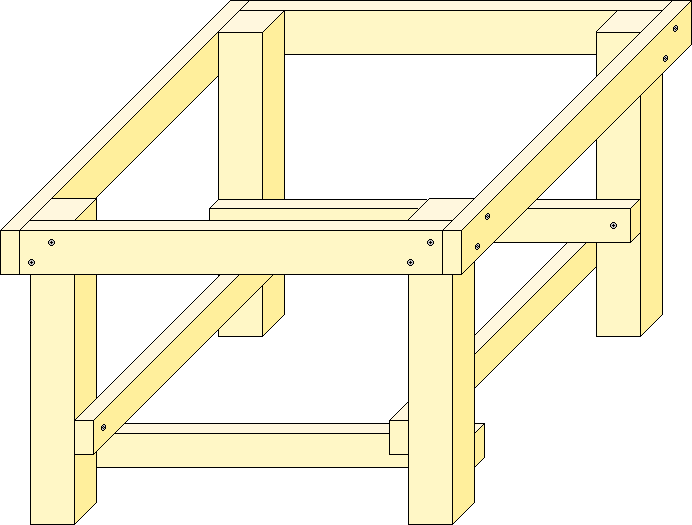Siting an Apiary
Hive Stands
Clonroche Hive Stand
|
|
|
|---|
|
Siting an Apiary Hive Stands Clonroche Hive Stand |
Stands for National Bee Hives |
|---|
Many methods are used by beekeepers to raise their hives from damp ground or simply to create a comfortable working height.
Pallets are sometimes used, either to facilitate transport or just because they are "available". I have used this method myself and I found two disadvantages, firstly they are usually only about 150 mm in thickness, and in the circumstance of using a single National brood box, the top bars of the brood frames are too low for best comfort. The second reason is that they are usually made with slatted tops using boards of roughly 100 mm width and spaced 20 mm - 25 mm apart, this restricts the airflow quit a lot and renders the area under the hive much more damp than you would expect. Pallets might appear to be an easy option, but they rot very quickly and I have seen a few disasters where the hive has collapsed. R.P.
In USA they commonly use a stand that is only 100 mm tall and has no airflow underneath at all... This allows a great deal of moisture to wick up from the ground and saturate the timber structure of the hive itself. Which in turn makes it more difficult for the bees to shed moisture whilst clustering (because the wood is already wet). This is made worse by the widespread use of paint on the exterior of the hives and so the American beekeepers have developed the technique of forcing ventilation by introducing a "top" entrance, albeit only small (10 mm hole) which allows the excessively damp air to escape. This again gives rise to increased consumption of stores by bees that are under unnatural stresses.
I have seen plastic milk bottle crates used as hive stands and if they are placed onto individual paving slabs (to block the damp) they are reasonable, but airflow is still very much restricted under the hive itself. I find plastic crates excellent for standing nuc's on. R.P.
 It is also common to place timber rails across supports
such as concrete blocks and place several hives on the rails.
This is very good from the airflow point of view, but vibrations are
transmitted to all hives whilst any one is being manipulated. This
disturbance can make the subsequent manipulation of the other hives
difficult. Sometimes the rails are formed into a raft by the addition of cross pieces.
I have used this type for over 40 years. I drive metal supports into the ground both sides of the blocks. What
to us laymen are known as "Celcon" blocks aren't very suitable. They are porous, then break up when frozen.
R.P.
It is also common to place timber rails across supports
such as concrete blocks and place several hives on the rails.
This is very good from the airflow point of view, but vibrations are
transmitted to all hives whilst any one is being manipulated. This
disturbance can make the subsequent manipulation of the other hives
difficult. Sometimes the rails are formed into a raft by the addition of cross pieces.
I have used this type for over 40 years. I drive metal supports into the ground both sides of the blocks. What
to us laymen are known as "Celcon" blocks aren't very suitable. They are porous, then break up when frozen.
R.P.
The version shown in the drawing below has proved durable and effective. Many may consider that it is "over the top" and that any old object will do, certainly the bees will not object either way. I have found that using a standardised item of this type is convenient, comfortable, very strong and stable and as a result I would recommend that the principle is more widely upheld. It is drawn to a scale of 1 pixel per mm.

| Parts List | All dimensions mm | All parts pine | ||
|---|---|---|---|---|
| QTY | L | W | T | Part |
| 4 | 304 | 44 | 44 | Leg |
| 2 | 460 | 44 | 18 | Outer top rail |
| 2 | 424 | 44 | 18 | Inner top rail |
| 4 | 424 | 34 | 18 | lower braces |
If this type of stand is placed on a paving slab with gravel surrounding the slab itself, this will help to keep weeds at bay or on uneven ground the slab may be bedded into the gravel for levelling. (Not a perfect level, just a slight lean towards the front for water run off.)
Originally written by Dave Cushman. Edited with additions by Roger Patterson.
Written... 28 February 2002, Upgraded... 04 December 2005,
|